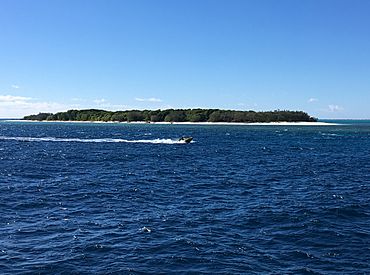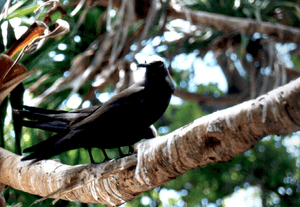Lady Musgrave Island facts for kids
Quick facts for kids Lady Musgrave IslandQueensland |
|
|---|---|
|
IUCN Category II (National Park)
|
|
 |
|
| Nearest town or city | Gladstone |
| Area | 0.275 km2 (0.1 sq mi) |
| Managing authorities | Queensland Parks and Wildlife Service |
| Website | Lady Musgrave Island |
| See also | Protected areas of Queensland |
Lady Musgrave Island is a beautiful coral island on Australia's famous Great Barrier Reef. It's about 14 hectares (35 acres) in size, with a huge coral reef around it that covers 1,192 hectares (2,946 acres). This island is the second most southern island in the Great Barrier Reef chain.
The island gets its name from Lady Lucinda Musgrave, who was the wife of Sir Anthony Musgrave, a governor of Queensland a long time ago. Local Aboriginal tribes call the island Wallaginji, which means "beautiful reef."
Lady Musgrave Island and its surrounding waters are protected as a national park. You can visit by taking a boat trip from Bundaberg or the town of 1770, Queensland. The island is also part of an important area for birds called the Capricornia Cays Important Bird Area.
Contents
Island Features
Lady Musgrave Island is a special kind of island called a "shingle cay." This means it's made up of small, flat stones and coral pieces. You can see exposed beach rock along its north-eastern and eastern shores.
The island has different types of trees, including Pisonia grandis, Tournefortia argentea, Casuarina equisetifolia, and Pandanus tectorius. These trees don't grow as thickly here as on some other nearby islands.
There's a small pond of slightly salty water towards the southern end of the island. The island sits at the southern end of a large, beautiful lagoon. Boaters love this lagoon because there's a deep channel that allows vessels to enter safely. People used to wonder if this channel was natural or if it was made wider by Japanese or Taiwanese fishermen, or even by guano miners many years ago. However, old records show the channel was there by 1938 and was mentioned in reports from 1875. It might have been widened by Captain William Collin after he repaired his ship, the Norseman, there.
Visiting the Island
Lady Musgrave Island is a popular spot for visitors! Two main companies offer day trips: Lady Musgrave Experience from Bundaberg and 1770Reef from the Town of 1770. Lady Musgrave Experience also has a special floating pontoon for day visitors and people staying overnight.
Lady Musgrave Island is one of the most visited camping islands in the Capricorn Bunker group. This is because its lagoon offers a safe place to anchor boats, and there are daily boat trips. It's important to know that the number of visitors allowed on the island is carefully managed to protect its natural environment.
A lighthouse was built on Lady Musgrave Island in April 1974 to help ships navigate. It's looked after by the Australian Maritime Safety Authority.
The island is part of the Capricornia Cays National Park. Camping is allowed on four islands in this park, with limits to protect them:
- North West Island: 150 campers
- Lady Musgrave Island: 40 campers
- Masthead Island: 60 campers (but only 30 from October to March)
- Tryon Island: 30 campers (currently closed)
There's no fresh water on Lady Musgrave Island, so visitors must bring all their own drinking water. There is a composting toilet available for campers. Many boats also visit the area, including private vessels and fast catamarans. The area is also important for fishing, especially for king prawns.
The island is far away from city lights, so the night sky is amazing for stargazing. You can often see meteor showers!
Island History
Discovery and Mapping
The first European to explore this area was Captain Eber Bunker in 1803, who was on a whaling ship called the Albion. He named the southern group of islands after himself.
Later, between 1819 and 1821, Lieutenant Phillip Parker King of the Royal Navy mapped the southern islands and reefs. In 1843, Captain Francis Price Blackwood continued this important work with his ships, HMS Fly and Bramble. A naturalist named Professor J. Beete Jukes was on board the Fly and wrote valuable notes about the islands.
Guano Mining in the 1890s
In the 1890s, people mined guano (which is bird droppings) on Lady Musgrave Island, Fairfax Islands, and North West Island. Guano was used as a fertilizer. This mining had already started on Lady Elliot Island to the south in the 1860s. You can still see some signs of these old mining activities today.
Lady Elliot Island was mined first in 1863. The miners then moved to Lady Musgrave Island, which they sometimes called "Bunker number 1." Fairfax Islands were "Bunker number 2." The mining caused a lot of damage to the island's plants. One miner wrote that the guano deposits on Lady Musgrave were "very meagre" (not much).
Tourist Resort in the 1930s
In the 1930s, there was a small tourist resort on Lady Musgrave Island. Today, only a concrete slab remains from this time. In 1938 and 1939, more buildings were added, including six cottages. The caretakers, Mr. and Mrs. Bell, encouraged visitors to protect the reef life. A boat called the Sapphire regularly brought tourists from Bundaberg to the island.
Military Target Practice
During the 1940s to 1960s, East and West Fairfax Islands were used as bombing ranges by the Royal Australian Air Force and Royal Australian Navy. It's thought that Lady Musgrave reef might also have been used for practice during World War II.
Ship Grounding Incident
On March 25, 1985, a large Australian ship called the TNT Alltrans ran aground (got stuck) on the reef near Lady Musgrave Island. The ship was carrying alumina (a material used to make aluminum) from Gladstone, Queensland to New Zealand.
The ship got stuck very close to the island's lighthouse. Luckily, no one was hurt, and there was no pollution from the incident. The ship was pulled free the next day and later repaired. The accident happened because the officer in charge of the ship was not paying enough attention to its navigation.
Island Wildlife and Environment
Plant Life
The main trees on Lady Musgrave Island are Pisonia (Pisonia grandis). You'll also find she-oaks and Pandanus tectorius trees.
Camping and Rules
Camping is allowed for up to 40 people at a time, but you need to book in advance, especially during school holidays. The island is closed to all campers in February and March to protect baby turtles hatching. You can find more information and book permits online. Campers can bring dive compressors (but only use them from 9 am to 6 pm). Generators are NOT allowed.
A tourist boat from 1770 can bring supplies to campers if arranged beforehand.
Wildlife
Lady Musgrave Island is home to many amazing birds! White-capped noddy terns build their nests in the Pisonia trees. Other birds like bridled terns, black-naped terns, and silver gulls nest on the ground near the beach. If a baby noddy tern falls from its nest, centipedes quickly eat it, returning nutrients to the soil.
From December to May, thousands of wedge-tailed shearwaters, also called 'mutton birds', nest in burrows (holes) in the ground. You can hear their unique calls at night. Be careful not to step off the paths, as their burrows can easily collapse.
From September to March, many different shorebirds visit the island, like ruddy turnstones and Pacific golden plovers. They look for food on the reef when the tide is low. Other birds, like Buff-banded rails and Capricorn silvereyes, live on the island all year round.
The island is also a very important nesting place for green and loggerhead turtles. During nesting and hatching seasons, you'll often find a turtle-research person camping on the island to help protect them.
In the shallow waters around the island, you might see small whitetip reef sharks and leopard sharks. These sharks are not dangerous to humans and are fascinating to watch.
Green and leatherback turtles can sometimes be seen resting on coral formations. The coral lagoon is full of many different kinds of fish and corals, making it a spectacular place for snorkeling!
Pests on the Island
Goats
Goats were brought to Lady Musgrave Island around the late 1800s by sailors and whalers. They left goats and coconut trees on many islands, thinking they would help shipwrecked people find food and water.
However, over time, these goats caused a lot of damage to the island's plants by eating too much. This was a problem on many islands in the Great Barrier Reef. People noticed the damage as early as 1928, with reports saying the goats had eaten away all the undergrowth and even gnawed the bark off trees.
In 1948, people tried to remove all the goats from Lady Musgrave Island, but some were brought back later. By 1974, about 300 goats were removed through hunting. Since then, the island's plants have recovered a lot.
Other Animals
African Guinea fowls were released on Lady Musgrave Island in 1974. It's not clear if they are still there today. Sometimes, large numbers of locusts or other insects are blown from the mainland to the island. In 1925, this caused many Pisonia trees on Lady Musgrave to lose their leaves.
Shipwrecks on the Reef
Over the years, several ships have been wrecked near Lady Musgrave Island or nearby reefs.
Jane Lockhart This 2-masted schooner (a type of sailing ship) sank between December 11 and 17, 1868. It was carrying cargo from Sydney and ran aground. While some reports said it hit Lady Musgrave Island, later news suggested it was actually on Heron Island, or possibly One Tree Island or Masthead Reef. The crew safely escaped in a boat. Parts of the ship and its cargo were later recovered.
Bannockburn The Bannockburn was a brigantine (another type of sailing ship) that was 85 feet long. On November 9, 1884, it struck "no.1 Bunker Island" (likely Lady Musgrave Island) and was refloated after some of its timber cargo was saved. It later became a total loss when it wrecked in the Fitzroy River in 1905.
Kokotu The motor vessel Kokotu struck a reef off Lady Musgrave Island during Cyclone Emily on April 1, 1972.
A small seaplane (registration VH-JLU) carrying passengers from Lady Musgrave Island crashed during take-off on January 5, 1998. The people on board only had minor injuries, but the aircraft was destroyed.
Around Christmas in 1990 or 1991, a fishing trawler caught fire and sank in the north-east corner of the lagoon.
See also
 In Spanish: Isla Lady Musgrave para niños
In Spanish: Isla Lady Musgrave para niños





